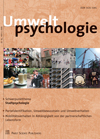Artikeldetails
 Sonja Haustein (2006),
Sonja Haustein (2006),Mobilitätsverhalten in Abhängigkeit von der partnerschaftlichen Lebensform.
Umweltpsychologie 10(2), 160-182.
Dieser Artikel wurde in deutsch verfasst.
| Zusammenfassung: | Seit Mitte der 60er Jahre ist eine Zunahme nichtkonventioneller Lebensformen zu Lasten der Ehe zu verzeichnen. Zur Untersuchung der Auswirkungen des Wandels partnerschaftlicher Lebensformen auf das Mobilitätsverhalten werden Singles, Personen aus Paarbeziehungen ohne gemeinsamen Haushalt und nichtehelichen Lebensgemeinschaften mit Ehepartnern verglichen. Die Datengrundlage stellt eine 2003 durchgeführte Befragung von 1206 20-55-Jährigen Personen aus Augsburg, Bielefeld und Magdeburg dar. Die Einschätzung von Singles als hochmobile Personengruppe wird zurückgewiesen und auf die häufig vorgenommene Gleichsetzung von Singles mit Personen in Einpersonenhaushalten zurückgeführt. Werden Singles über ihre Partnerlosigkeit operationalisiert, verfügen sie im Durchschnitt über eine Verkehrsleistung die der von Ehepaaren entspricht und deutlich unter der von Partnerschaften ohne gemeinsamen Haushalt und nichtehelichen Lebensgemeinschaften liegt. Bei einem weiteren Zuwachs dieser beiden Partnerschaftsformen, die oft mit hohen Mobilitätszwängen einhergehen, ist mit einer Erhöhung des Berufs- und Freizeitverkehrs und entsprechenden negativen Folgen für Mensch und Umwelt zu rechnen. |
| Schlagworte: | Berufsmobilität Freizeitmobilität Mobilitätsverhalten Partnerschaften ohne Gemeinsamen Haushalt Partnerschaftliche Lebensformen Singles |
| Abstract: | Since the middle of the sixties a change in living arrangements based on partnership can be noticed. It manifests itself in an increase of alternative family forms and a decrease of married couples. In this study, singles, living apart together relationships (LATs), and cohabitants were compared with married couples with regard to their mobility behaviour. The database consisted of a survey of 1.206 residents of three big German cities conducted in the year 2003. The common assumption that singles are a highly mobile group of persons was rejected. This assumption could be traced back to the fact that singles were often equated with persons in one-person households. If they were operationalised via being partnerless, their distance travelled per person corresponded approximately to that of married couples and was far below the distance travelled by LATs and cohabitants. Whilst cohabitants had a high amount of occupational mobility, LATs were highly mobile in their leisure time. A further increase of these two living arrangements, which are often associated with certain mobility necessities, will lead to a corresponding increase of occupational and leisure time mobility, implying negative effects for man and environment. |
| Keywords: | Behavior Cohabitation Conservation Ecological Living Arrangements Single Persons Transportation |
Zum Inhaltsverzeichnis

